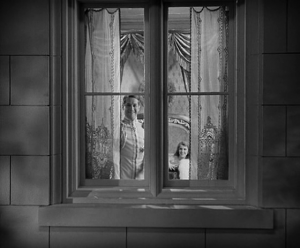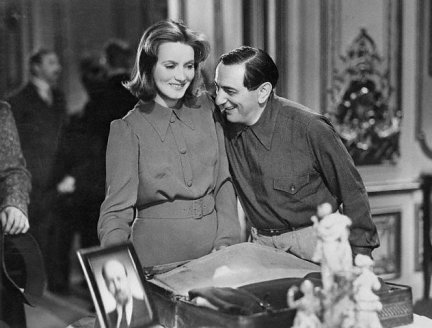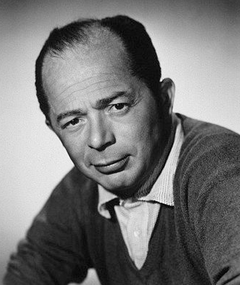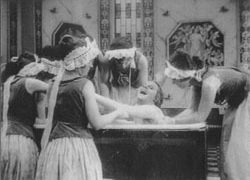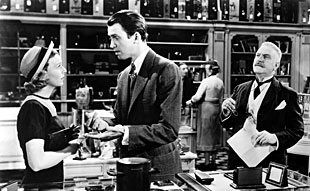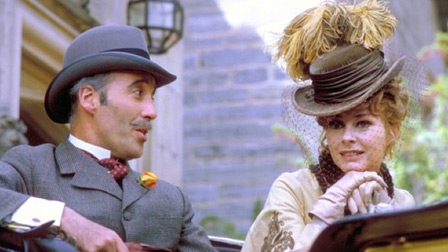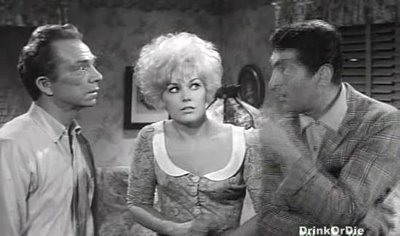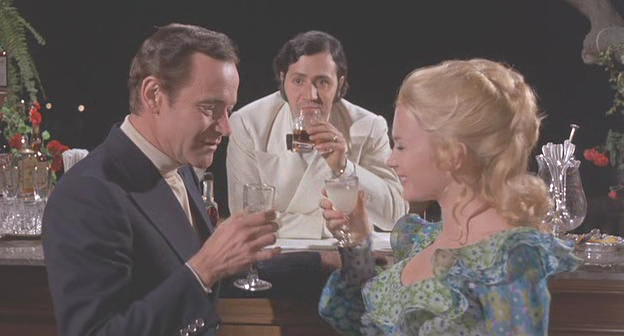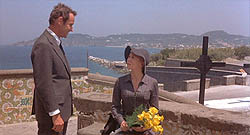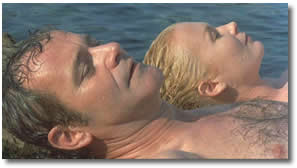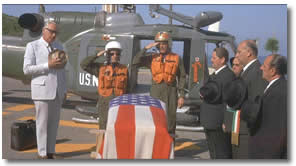This originally appeared in Stop Smiling‘s “Hollywood Lost and Found” issue (2007); it’s also reprinted in my latest collection. — J.R.
The camera cranes around the grand façade of a palace, a chateau, or a luxurious grand hotel, peering obliquely through the windows at the various doings inside. Or it stays perched in a hallway, outside a bedroom or a suite inside one of these buildings, while servants, musicians, or cigarette girls enter or leave, encouraging us to imagine what romantic shenanigans might be taking place on the other side of the door.
These are the two main signature shots of the great Hollywood filmmaker Ernst Lubitsch — especially during his Hollywood heyday, the 30s -— and one can also find variations of the second kind, the outside-the-door interiors, in the more romantic movies of Billy Wilder, Lubitsch’s major disciple, whose own Hollywood heyday was the 50s. In Lubitsch’s Ninotchka (1939), which Wilder and his frequent writing partner Charles Brackett helped to script, we’re made to understand how much three Russians in Paris (Sig Ruman, Felix Bressart, Alexander Granach) on a government mission are enjoying themselves in their hotel suite when they order up cigarettes, meaning three cigarette girls. And in Wilder’s Love in the Afternoon (1957) —- the most obvious and explicit and also, arguably, the clunkiest of his tributes to Lubitsch, partially inspired by Lubitsch’s 1938 Bluebeard’s Eighth Wife (which Wilder and Brackett also helped to script, and which also starred Gary Cooper, again playing a womanizing American millionaire in France) —- the camera periodically returns to its favorite spot, outside the millionaire’s suite at the Ritz, whenever the Gypsy musicians he hires arrive to help him pull off his various seductions with their soulful rendition of “Fascination”.
Despite their reputations, I’m afraid that neither Ninotchka nor Love in the Afternoon qualifies as a favorite of mine. Among other things, they’re both limited by the fact that Cary Grant refused to play their male leads. (In Ninotchka, Melvyn Douglas took that part, opposite Greta Garbo; and in Love in the Afternoon, where Audrey Hepburn plays the daughter of Paris detective Maurice Chevalier, it would have been more interesting if Cooper had played her father and Chevalier had played her lover.) But I’m beginning with these examples because they offer the simplest and clearest illustrations of what “the Lubitsch touch” consists of.
As counter-examples, I’d like to propose the tributes to Lubitsch offered by two French New Wave directors, Jean-Luc Godard and Alain Resnais, both of whom allude to the exterior, horizontal crane shots around façades that can be found in many of Lubitsch’s musicals with Chevalier and Jeannette MacDonald as well his supreme comedy of the 30s, Trouble in Paradise [see photo above]. Both examples, I should add, are readily available, because the two French films in question (along with Trouble in Paradise) are now accessible in excellent DVD transfers.
In Godard’s A Woman is a Woman (1962), one of the leads, Jean-Paul Belmondo, plays a character named Alfred Lubitsch, and the first time we hear his surname, he’s being called to the phone. We then cut to a curious long shot of an apartment house façade where a neighbor on the top floor climbs out his window onto a catwalk and then walks around the side of the building to Alfred Lubitsch’s window. There’s no camera movement; but this is a low-budget comedy and Godard clearly couldn’t afford a crane, so he merely suggests the movement with the neighbor’s trajectory.
By contrast, in Resnais’ relatively big-budget Stavisky… (1974) — which also stars Belmondo (in the title role), and is set in 1933 —- there’s a breathtaking piece of mise en scène crafted in and around a palatial resort hotel in Biarritz that actually looks even more opulent and elegant than anything to be found in Lubitsch. It’s all part of a flashback away from Stavisky and his friend Baron Raoul (Charles Boyer) in Paris, narrated by the latter as he describes his recent visit to Biarritz, where he saw Stavisky’s wife Arlette (Anny Duperey). As the Baron in this flashback enters the super-deluxe hotel where Arlette is staying, to the haunting strains of Stephen Sondheim’s first movie score, and takes the elevator, there’s a crane outside the building charting his progress through French windows [see two photos above] as he crosses her sumptuous suite, a flurry of crisscrossing maids marking his path, until we see, through the last of the many windows, Arlette getting dressed in her bedroom. Then there’s a startling, very un-Lubitsch-like cut from the Baron knocking on her door to a closeup of her swiftly turning her head in response to his knock. It’s a bit like waking from a swank, Lubitschian dream —- an apt effect, because back in the present, Stavisky is asking the Baron about a nightmare that Arlette had, a seeming premonition of his own downfall.
***
Based on these affectionate tributes, one might ask more generally, what did the famous “Lubitsch touch” consist of, exactly? “It was the elegant use of the superjoke,” said Billy Wilder, Lubitsch’s most famous and enduring Hollywood disciple, to the much younger writer-director Cameron Crowe in the interview book that they did together (Conversations with Wilder, New York: Knopf, 1999). According to Wilder, it was a kind of extra spin on a comic situation —- the sort of thing that once prompted Wilder as a screenwriter to place a sign on the wall of his office saying, “How would Lubitsch do it?” Wilder, a Viennese Jew, used Lubitsch, a Jew born in Berlin, as a major reference point throughout his filmmaking career, and to what degree he succeeded as well as failed in emulating his master is the main issue I’d like to address here. Both filmmakers tended to use little-known European stage farces, often French or Hungarian, as springboards for their own comic inventions, and both had a singular way of juxtaposing European and American customs and styles of behavior as a subtle way of critiquing as well as appreciating both.
Wilder’s best example of what he meant by “the Lubitsch touch” was a suggestion Lubitsch made during the scripting of Bluebeard’s Eighth Wife: “Gary Cooper goes down the street in Nice, and what he’s looking for is maybe in a shop, a big, big shop like Macy’s. In the store window was information written out, FRENCH SPOKEN…DUTCH SPOKEN …ITALIAN SPOKEN…CZECHOSLOVAKIAN SPOKEN…and the last one was ENGLISH SPOKEN. The kind of thing you see in Nice. Then underneath that —- this was [Lubitsch’s] idea —- he added one more line: AMERICAN UNDERSTOOD. That was Lubitsch. [Laughs.] We had no joke there before.”http://www.jonathanrosenbaum.net/wp-content/uploads/2010/10/lubitsch_oyster.jpg
Wilder himself [see above] insisted that Lubitsch was inimitable, recalling a famous exchange between himself and fellow director William Wyler when they were both pallbearers at Lubitsch’s funeral in 1947. “No more Lubitsch,” Wilder sadly noted, to which Wyler added, “And worse, no more Lubitsch pictures.”
But for all his admiration for Lubitsch, Wilder was no film historian. He claimed to Crowe that Lubitsch “didn’t do any comedies in Germany, he did great big expensive historical pictures” —- an account that omits two of the funniest German comedies ever made, Lubitsch’s Die Puppe (The Doll) and The Oyster Princess [see two photos above]. both made in 1919 — and other Lubitsch silents that were “historical” (i.e., costume) pictures but also comedies, such as Romeo and Juliet in the Snow (1920) and The Wildcat (1921). (Incidentally, excellent restorations of both The Oyster Princess and The Wildcat are available on DVD.) Wilder also claimed that after The Marriage Circle in 1924 —- Lubitsch’s second Hollywood picture, after Rosita (1923), a comedy set in 1840s Spain —- the master stuck exclusively to comedies, which is almost but not quite true: the exception was the underrated and sincere but commercially disastrous antiwar drama with a post-World War I setting, The Man I Killed (1932), also known as Broken Lullaby — which also proved to be Lubitsch’s first collaboration with the man who became his best screenwriter, Samson Raphaelson, the author of The Jazz Singer who also worked on all three of Lubitsch’s supreme masterpieces: Trouble in Paradise (1932; see photo below), The Shop Around the Corner (1940; see second photo below), and Heaven Can Wait (1943; see third and fourth photos below), all fortunately available in excellent DVD editions.
I’d like to propose a somewhat different definition of “the Lubitsch touch” — one that helps to account for why Wilder was able to adopt some of its aspects on his best pictures while other aspects eluded him. It’s a definition that comes in three parts. Part one, as I’ve already suggested, is a specifically Eastern European capacity to represent the cosmopolitan sophistication of continental Europeans to Americans — and with a double edge, as becomes clear in the “American understood” gag. Lubitsch himself was well aware of the ironies involved in his role as a cultural translator: “I’ve been to Paris, France and I’ve been to Paris, Paramount,” he once famously remarked. “Paris, Paramount is better.” This was arguably one of his few immodest claims, because “Paris, Paramount” was practically his own invention. And he differed from his silent, Viennese predecessor Erich von Stroheim in the way he packaged his expertise for the public. As Stroheim once said, “Lubitsch shows you first the king on his throne, then as he is in his bedroom. I show you the king first in his bedroom so you’ll know what he is when you see him on his throne.”
Part two of “the Lubitsch touch” wasn’t so much a touch as a kind of guarded embrace. It was actually a vision — a way of regarding his characters that could be described as a critical affection for flawed individuals who operate according to double standards. This probably doesn’t take in Lubitsch’s entire Hollywood oeuvre, but it does seem to apply to all the American comedies mentioned above, as well as such other gems as —- sticking only to sound films — The Love Parade (1930), Monte Carlo (1931), The Smiling Lieutenant (1932), and To Be or Not To Be (1942).
Two of the three leading characters in Trouble in Paradise, played by Herbert Marshall and Miriam Hopkins, are jewel thieves in Venice and Paris who double as consummate con artists, playing their trade on each other as well as on other victims, such as an heiress played by Kay Francis. These breezy crooks are romantic hypocrites who can’t be simply condemned or simply applauded and one might describe the Lubitsch touch here as a rare capacity to view their romantic and hypocritical sides with equal amounts of nuanced attention and moral complexity without succumbing to any sentimentality about them. Similarly, the very different romantic leads of The Shop Around the Corner — two repressed and lonely clerks employed at a Budapest notions shop, played by James Stewart and Margaret Sullavan, who snap at each other at work without realizing that they’re also passionate penpals who believe they haven’t yet met. By giving so much attention to their cranky peevishness with one another, Lubitsch makes their secret amorous sides even more touching. And the rakish hero played by Don Ameche in Heaven Can Wait is another version of the same kind of duplicity —- a man who clearly loves his wife (Gene Tierney) yet periodically cheats on her throughout his life.
The third and simplest part of my own definition of The Lubitsch Touch would be a graceful way of handling music as an integral part of a film’s construction. This talent, I would submit, is the one clear way in which Wilder even surpassed his master: in his supreme late masterpieces The Private Life of Sherlock Holmes (1970) and Avanti! (1972), it is largely his exquisite uses of music — a score by Miklos Rozsa in the first, a collection of Italian pop songs in the second —- that makes these movies as memorable as they are.
***
Wilder, who also started out as a Paramount director, eventually left the studio after some executives there tried to persuade him to change the German villains in Stalag 17 (1953) — a World War II comedy-drama set in a concentration camp — into Poles, in order not to interfere with the film’s potential German market. (As someone who’d lost much of his family in the Holocaust, Wilder was understandably offended.) The fact that he started out as a journalist may have been the most significant of the differences in background between him and Lubitsch, for it might be argued that one of the strongest aspects of his work is a kind of quasi-documentary realism that places him in a world that’s very different from that of Lubitsch. Think of the documentary aspects of Wilder’s greatest noncomic films, such as Double Indemnity (1944), Sunset Boulevard (1950), and Ace in the Hole (1951; see first photo below), with their indelible portraits of Los Angeles, Hollywood, and New Mexico, and you can already see part of what would make such later comedies as One, Two, Three (1961; see photo above), Kiss Me Stupid (1964; see second photo below), The Private Life of Sherlock Holmes and Avanti! distinctive —- namely, their canny uses of locations in Berlin, Nevada, London and Inverness, and southern Italy, conveying a sense of actuality that no studio simulations could approximate.
If he had a comic theme of its own that made him more cynical than Lubitsch — even at times a sour misanthrope — this might be described as the double standard that drives his characters into elaborate and often tortured deceptions. The classic example would be Tony Curtis and Jack Lemmon as jazz musicians on the run from Prohibition gangsters who wind up in drag, playing in an all-girl band at a plush resort hotel, in Some Like it Hot (1959), Wilder’s most popular comedy. But one can also cite The Seven Year Itch (1955), Love in the Afternoon, One, Two, Three, Kiss Me Stupid, and The Fortune Cookie (1966), among many other examples.
Both Lubitsch and Wilder had reputations of being “naughty” as comic directors. But it’s worth noting that in some ways the topics of capitalism and class are even more taboo as topics of discussion in American culture than sex, and from this standpoint, part of the naughtiness of both directors had to do with their treatment of these topics, especially from the perspectives of their respective eras. There are few 30s comedies that have a more morally complex view of capitalism than Trouble in Paradise, and few comedies of the 50s, 60s, and 70s that expose the potential ugliness of capitalism more directly than Ace in the Hole, Sabrina (1954), The Apartment (1960), One, Two, Three, Kiss Me, Stupid, The Fortune Cookie, and Avanti! (In Lubitsch’s films, by contrast, in keeping with 30s fantasies about wealth, we most often get royalty and military pomp instead of capitalism —- which is in part why Maurice Chevalier wound up as his standby actor, much as Jack Lemmon would subsequently become the favorite actor of Wilder.)
In keeping with this topic, Wilder is often drawn to characters whose strongest suit is a certain vulgar vitality: think of Kirk Douglas’ ruthless journalist in Ace in the Hole, or James Cagney’s Pepsi Cola executive in One, Two, Three. In this respect he is quite unlike Lubitsch, who ridicules both actors and Nazis in To Be or Not To Be for their vanity and childishness but would never dream of celebrating anyone’s coarseness the way Wilder would. And on the matter of sex, one should note that male homosexuality and crossdressing crop up repeatedly in Wilder’s work as comic standbys, but they hardly appear at all in Lubitsch’s. Think of how much comic mileage is wrested out of men dressed as women in Stalag 17 or Some Like it Hot, or out of suggestions of gay behavior in the opening sequences of both The Private Life of Sherlock Holmes and Avanti!
***

Was Lubitsch really inimitable? I bring this matter up because there are some characteristic “Lubitsch pictures” that he oversaw as Paramount’s production chief that were mainly or exclusively directed by other people, such as Love Me Tonight (1932, directed by Rouben Mamoulian; see photo above), One Hour with You (1932, codirected by George Cukor), and Desire (1936, directed by Frank Borzage). A few critics even plausibly maintain that Love Me Tonight — starring Maurice Chevalier and Jeanette MacDonald, the romantic leads in Lubitsch’s The Love Parade, The Smiling Lieutenant, and The Merry Widow (1934) —- is superior to the musicals Lubitsch directed.
On the other hand, one could argue that Wilder’s greatest applications of “the Lubitsch touch” are those that get beyond the master’s surface tics and in some ways might even be said to beat the master at his own game in sympathetically critiquing his characters while satirizing certain national traits. (Interestingly enough, this never happened during his excursions to Paris: in Love in the Afternoon, the cliché observations about the city, like those about the French in general, feel like second-hand derivations from Lubitsch, while the French caricatures in the blowsy 1963 Irma la Douce are strident as well as phony.)
For me, Wilder’s most profound treatments of Europeans occur in two of his late masterworks, made back to back, both of which tanked at the boxoffice – The Private Life of Sherlock Holmes and Avanti!, movies which register as definitive statements about English repression and Italian sensuality (in addition to Italian bureaucracy in the latter movie). In the case of the Holmes film, it’s the whole Victorian era, including Queen Victoria herself, that’s submitted to Wilder’s critical scrutiny, and the sensuality of a Continental heroine played by Genevieve Page figures centrally in throwing the hero’s inhibitions into relief. In both films, working with his favorite and perhaps best collaborator, cowriter I.A.L. Diamond, Wilder uses material derived from others (characters in the former, a play in the latter) to create a story that is highly personal.
It’s a pity that Wilder himself didn’t value these films more. In his interview book with Crowe, he confesses that he essentially abandoned The Private Life of Sherlock Holmes after it had an unsuccessful preview, allowing it to be extensively cut by others, and he’s mainly disparaging about Avanti!, in part because of what might be regarded as one of its greatest strengths: “It smelled that it was shot in Italy,” he complained —- as if a studio-created artificial Italy would have been better, matching Lubitsch’s own preference for Paris, Paramount over Paris, France. But the journalist in Wilder turns out to be a lot more relevant than the more celebrated confectioner, and in some respects the filmmaker’s images, which are usually overlooked, are allowed to supersede his words: both films essentially begin with pungent sequences without dialogue that bring us back to the expressiveness of silent cinema. (Avanti! is also exceptional in Wilder’s work for its profanity and nudity — not to mention the degree to which it actually qualifies as an Italian film because of the number of Italians who worked on it, and the amount of unsubtitled Italian dialogue it employs, without ever allowing viewers who don’t understand the language to lose the narrative thread.)
Both films have rather inhibited heroes —- the brilliant but withdrawn and emotionally armored Holmes (Robert Stephens) in the first, a brash but inexperienced and prudish American businessman from Baltimore named Wendell Armbruster Jr. (Jack Lemmon) in the second — with consequences that are respectively tragic and comic. Holmes, the ultimate sophisticate and cosmopolitan, turns out to be an extremely vulnerable innocent when it comes to women and affairs of the heart, periodically driving him back into the solace of his cocaine addiction. And even though there are no American characters in The Private Life of Sherlock Holmes, I think it could be argued that Dr. Watson (Colin Blakely) as Holmes’s incredulous comic foil functions here in the same way that an American character among Europeans would in a Lubitsch movie. (He’s the supposedly commonsensical character whom Holmes periodically has to explain the plot to when it’s actually us, the Yankee rubes, who have to be clued in.)
All of Wilder’s ambivalences about both Europe and the U.S. are held in exquisite balance in Avanti! (1972), perhaps the least known but surely the most achieved of all his Lubitsch-style comedies, which over the years has gradually become my favorite of all his pictures. It describes the very brief romance that ensues between the aforementioned Armbruster and a working-class English woman named Pamela Piggott (Juliet Mills), when they meet at a health resort and luxury hotel not far from the bay of Naples. They’ve arrived at this particular spot because his father and her mother, who’ve just died together in a car accident, had been carrying on a secret affair at this hotel for a month every summer over the past decade —- something Piggott knew about that was completely unknown to Armbruster Jr. As they discover and essentially recapitulate various details about their parents’ amorous past at the same hotel, the quintessential German appreciation for Italian culture (equally apparent in such literary classics as Death in Venice), which also encompasses here a lot of satirical observation, becomes the main bill of fare. (Curiously, one reason why Wilder was himself disappointed with the way this film turned out was that he originally wanted Armbruster Sr.’s long-term affair to have been with a male hotel bellhop, until studio executives dissuaded him.)
Both Wendell Armbruster Jr. and Pamela Piggott are flawed individuals, to say the least: he’s brash and shallow, the ugliest of “ugly” Americans in confronting Italian customs, and she’s a neurotic obsessed with being overweight. Yet as with Cervantes’ pairing of Don Quixote with Sancho Panza, the pairing of their separate faults makes the two of them irresistible, and far greater than the sum of their parts. It’s characteristic of Wilder’s mastery of this romantic material — which he adapted with Diamond from a play by Samuel A. Taylor, the author of Sabrina — that (a) a full two hours of the movie’s 144 minutes pass before the couple finally arrive at a kiss and that (b) it’s well worth the wait. Thanks to Wilder and Diamond’s careful script construction, this happens at precisely the same moment that an American who’s even more boorish, insensitive, and clueless than Armbruster suddenly arrives on the scene — a yahoo government bureaucrat named Blodgett, astutely played by Edward Andrews — who makes Armbruster seem like a civilized role-model by comparison.
Is it possible to speak of a Wilder touch? I think so, especially if one thinks about the writer- director’s subtle and delicate way of charting the emotional lives of Sherlock Holmes and Wendell Armbruster Jr. in these late masterpieces. Come to think of it, I think even Lubitsch might have been envious.

